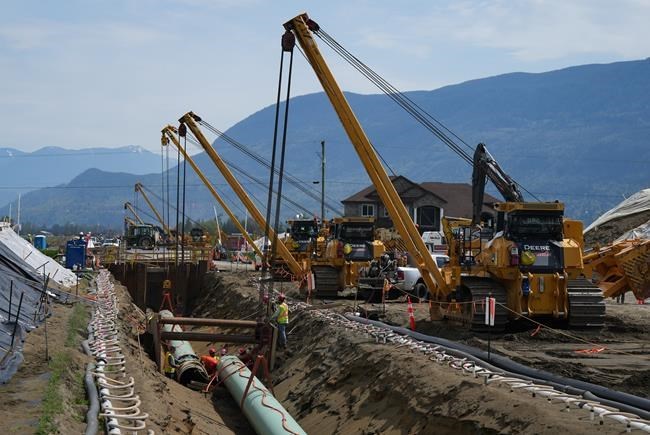CALGARY — The imminent completion of the Trans Mountain pipeline expansion is more likely following Friday's decision by the saąúĽĘ´«Ă˝ Energy Regulator to approve a request for a pipeline variance from the company building the project.
While the regulator imposed a number of conditions, including testing and documentation requirements for the pipe materials, it said Trans Mountain Corp. can begin constructing the variance right away.Â
The regulator said it will issue the reasons for its decision at a later date.
The decision — issued Friday evening just hours after the conclusion of a hearing in Calgary — is significant for saąúĽĘ´«Ă˝'s energy sector, which has been eagerly anticipating the startup of the massive pipeline project.
The Trans Mountain pipeline is saąúĽĘ´«Ă˝'s only oil pipeline to the West Coast and its expansion will increase the pipeline's capacity to 890,000 barrels per day from 300,000 bpd currently. Â
Its construction, which is more than 98 per cent complete, has been underway for more than three years. Canadian oil producers have begun ramping up production in expectation of the additional export capacity, which is expected to improve the prices Canadian oil companies receive for their production.
But Trans Mountain Corp., the Crown corporation behind the project, has been racing against the clock. Construction was expected to be complete in the first quarter of this year, but the company has run into difficulties drilling through hard rock in saąúĽĘ´«Ă˝
Its initial request to use a different size of pipe for the location in question was denied by the regulator due to concerns around pipeline quality and integrity.Â
Trans Mountain Corp. then asked the regulator to reconsider, saying in December that the project could face a worst-case scenario of a two-year delay in completion if it was not allowed to alter its construction plans.
At Friday's hearing, the Crown corporation urged the regulator to make a decision quickly on whether or not the company will be allowed to change the size, thickness and coating of a 2.3-kilometre stretch of pipe between the communities of Hope and Chilliwack, saąúĽĘ´«Ă˝Â
The company argued it can address all of the regulator's concerns around the sourcing and integrity of the alternate pipe size, and urged the regulator to avoid imposing conditions that would result in a "material" delay to the project.
Lawyer Sander Duncanson, who represented Trans Mountain Corp. at the hearing, said that for each week the project's completion is delayed, the pipeline company expects to lose $50 million in lost oil shipping revenue.
"The commission must be mindful that every day counts now," Duncanson said.
"An extra week of deliberations, or a condition that requires an extra week or two before Trans Mountain can start up the expansion, may not seem like a big deal. But it will have real, material impacts."
The company has said the pipeline can enter service within one month of mechanical completion of the project.
In a statement posted to its website Friday evening, Trans Mountain Corp. said it will now proceed in compliance with the order approving the variance.
"Trans Mountain appreciates the timely response from the CER," the company said in its statement.
The Trans Mountain pipeline is owned by the federal government, which purchased it in 2018 in an effort to get the expansion project over the finish line after it was scuttled by previous owner Kinder Morgan saąúĽĘ´«Ă˝.
The project's costs have spiralled through the course of construction from an original estimate of $5.4 billion to the most recent estimate of $30.9 billion.
Trans Mountain Corp. has blamed the ballooning costs on a number of things, including evolving compliance requirements, Indigenous accommodations, stakeholder engagement and compensation requirements, extreme weather, the COVID-19 pandemic and challenging terrain.
"When you operate in a technically challenging environment, sometimes things that are unforeseen happen," Duncanson told the regulatory panel Friday.
"I'm cautiously optimistic that this is the last (problem)."
This report by The Canadian Press was first published Jan. 12, 2024.
Amanda Stephenson, The Canadian Press



